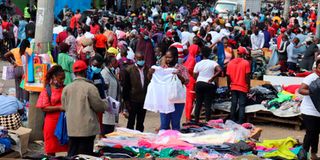Second-hand clothes traders spend Sh28bn on imports

Second-hand clothe buyers and sellers at Gikomba market in Nairobi on June 13, 2021.
Kenyan traders spent nearly Sh28 billion to ship in second-hand clothes in the year ended March, signaling rising demand for used attires in a blow to President William Ruto’s renewed policy of promoting local garment making.
The import bill for mitumba, grew by a third (33.32 per cent) in the 12-month review period to Sh27.82 billion, according to the latest trade data collated by the Kenya National Bureau of Statistics (KNBS).
Higher quality and relatively lower prices for used attires have continued to drive demand for the merchandise at the expense of locally made clothes amid higher margins enjoyed by traders largely in informal markets.
The lucrative second-hand clothing segment has seen traders from China —a key source market for the merchandise —open shops in Gikomba, Kenya’s largest informal market for second hand goods in recent years to cash in on rising demand.
“The number of people getting into this business is increasing every day. This is because the capital required is very small, but it requires you to be self-driven to be in this trade and succeed,” Teresia Wairimu, chairperson of Mitumba Consortium Association of Kenya, said on phone.
“Mitumba traders are taxpayers and once you pay taxes you get the support from the government, especially the agencies at the port [of Mombasa].”
A 40-foot container will on average cost about $50,000, inclusive of all taxes and clearance charges, according to traders.
The KNBS data shows traders and households shipped in 206,580 tonnes of used clothes in the year ended March, a 14.53 per cent rise from 180,367 tonnes the year before.
Higher importation of used clothes is a blow to the Ruto administration, which has listed the garments and textiles sector among key sectors with “huge untapped potential of employing thousands of Kenyans” besides earning the country “significant foreign exchange” in exports.
“However, the sector is confronted by numerous challenges including the high cost of labour and low agricultural productivity that hampers the competitiveness of Kenya’s garment export,” Treasury said in the 2024 Budget Policy Statement (BPS).
The increased imports of used clothes for resale came at a time when three members of the 27-nation European Union banned exports in line with the Basel Convention on the Control of Transboundary Movements of Hazardous Wastes and Their Disposal.
The push by France, Denmark, and Sweden for the enforcement of the treaty which seeks to ban exports of hazardous textile waste, prompted Ms Wairimu to visit Europe where she argued against the proposal.





